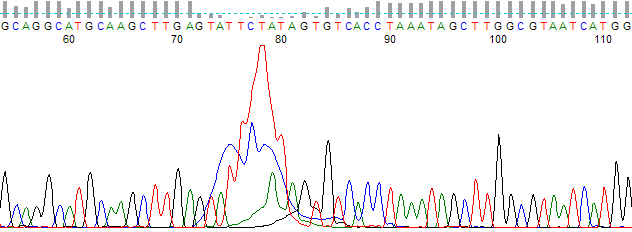DNA sequencing problems caused by excess free dye terminators
Identifying Dye Blobs
- The trace has one or more large, broad peaks in the region from bases 50 and 140 (Figures 1 – 3).
- Each large peak color appears at different base positions as separate peaks (Figure 1).
 Figure 1. Example of a trace with a moderate dye blob problem.
Figure 1. Example of a trace with a moderate dye blob problem.
 Figure 2. Example of a minor dye blob problem. Note the inclusion of the C at approximately base 73.
Figure 2. Example of a minor dye blob problem. Note the inclusion of the C at approximately base 73.
 Figure 3. Example of a minor dye blob problem. Note that the base call is not compromised, however the quality scores are low over the dye blob region..
Figure 3. Example of a minor dye blob problem. Note that the base call is not compromised, however the quality scores are low over the dye blob region..
Causes of Dye Blobs Problems
- Poor post-sequencing clean up. The most common cause of this is when the wrong ethanol concentration used (ie too high a concentration is used).
- Lost pellet. When the DNA pellet is lost during clean up (usually at the 70% ethanol wash step) the remaining small amount of Big Dye can appear as large dye blob peaks.
- Failed reaction. When a reaction fails the small amount of leftover dye can appear as large dye blob peaks.
Solving Dye Blobs Problems
- Check that the clean-up protocol was followed correctly. In general, ethanol based sequencing clean up protocols are very sensitive to changes in their parameters. Problems to look for are: the right ethanol concentration was used, the right salt concentration was used, the right incubation time, and the right centrifugation time were all used.
- Take extra care during the ethanol wash steps so as to avoid losing the DNA pellet. Consider spinning sample again before removing the ethanol wash solution. This can help avoid drawing off the loose DNA pellet with the 70% ethanol wash solution.
- Check the ethanol. 100% ethanol absorbs water from the air as soon as the bottle is opened. For this reason it is often better to use 95% ethanol to make up the final ethanol solutions.
- Consider using a non-ethanol based clean up protocol. There are a number of commercial clean-up kits that work very well. These kits might be more expensive than using an ethanol precipitation, but think how much each failed reaction is costing you!
- Check to see if the sequencing reaction has failed by examining the raw trace data using software like our QualTrace system. If the reaction has failed then the dye blob problems is mostly likely only an artefact of having no trace signal present.
For more information on automated QC tracking of sequencing traces please visit the QualTrace DNA sequencing analysis software page.
Return to the main DNA sequencing troubleshooting page.
